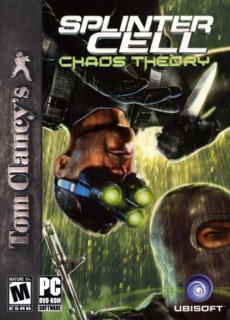The best stealth game to date.
The story is your typical Tom Clancy fair. That means it's fairly predictable, but definitely entertaining. Like past games you play as Sam Fisher an agent for "Third Echelon" a covet-ops branch of the NSA. The story begins with rising tensions between North Korea, China, and Japan, after Japan creates an Information Self Defense Force. Claiming this to be a violation of the Post WW2 Treaty (Japan will formally renounce war as a sovereign right and will not settle international disputes through the use of force) China and Korea begin to attack Japanese shipping. In order to dissuade the Chinese from this course of action, the USA sends in their most advanced warship, the USS Clarence E. Walsh. When the warship is destroyed, it's up to Sam to figure out who was responsible, and to hopefully prevent an inevitable war.
The stealth mechanics have been greatly improved. In addition to your your visual indicator, there is now an aural one that show your noise, and the ambient noise. In loud areas you can even sprint, in quiet ones you must move very slowly. You would not believe the difference that this feature makes.
Another large improvement is the much more realistic body detection system. In past games the game would scan to see if any bodies had been left out in the open. Even if there was no way that body could be found, the game would penalize you by giving you an alarm. Now the body must actually be "discovered" by a patrolling guard or seen by a camera. It's a much more realistic system, and it's a welcome change; of course it's still not very wise to leave bodies unhidden.
The last major improvement to the stealth department is the alarms. While alarms can still go off, and enemy soldiers will don better gear (helmets, flak jackets, etc.) you can no longer fail after sounding too many alarms. It's a nice change which cuts down on frustration.
My personal favorite new addition is the knife. Sam can now with the press of a button kill an enemy. This is useful if you need to guarantee a one hit knockout, or if you screw up (as you can run up and quickly rectify the situation). Sam's other environmental moves have been expanded. You can now grab enemies while hanging from above and snap their neck. If your below an enemy, you can pull him over the railing and fling him to his death. Their our other environmental kills to consider to. Try shooting a sticky shocker into a puddle where a few guys are standing. Sizzle.
Sam's weapons are back and are better than ever. The pistol now has a Optically Channeled Potentiator, basically an EMP laser that can temporarily disable lasers, cameras, etc. Sam's rifle, the SC-20K, now has a rifle attachment and a shotgun one. If you want to snipe someone, go for it. Need to clear a room, you know what to do.
Final improvements are noticeable in the AI. Enemies now take cover, learn around corners, and work as a team. As usual they react to environmental conditions, so if you break a light they'll notice. If they think they heard or saw something, they'll light a flare or shine a light in your direction. Today, the AI is still impressive.
Level design is more open than before. Many missions have numerous approaches. While it's still a stealth game, some brute force is possible thanks to Sam's enhanced firepower. If you really look, you can always find a perfect way through a mission without even knocking out a single enemy. There's much more player choice involved in this installment.
Graphically the game still looks nice even today, in some departments. Lighting is still suburb, as is the shadow work. Characters get slickly wet if they stand in the rain. Lightning can alert them to your presence. The animation looks good as usually with all of Sam's moves looking really good. Models are a bit blocky though, and sometime stretch oddly, but that's a small blemish on a solid visual presentation.
Sound Design is very, very good, and puts out a strong effort. With the addition of the aural meter, sound plays a much bigger role on the game play. The SFX themselves are very good. The amount of different footsteps depending on speed, and surface are mind-boggling. Michael Ironside does a good job as Sam Fisher himself, and other characters put up a good show as well. I'm not a huge fan of the hip-hop-esuqe soundtrack (if I had to have anything close, I would've preferred electronica), but there's no denying that it's well done and if you like the genre then you'll probably love it.
Splinter Cell Chaos Theory is phenomenal. The improvements are numerous and I've only listed a few. The more open level design enhances replayability and gives the SC games more of a realistic feel. It's probably the smoothest and most polished Splinter Cell title made and unfortunately such a high note meant the series would start to decline (Double Agent, Conviction).

